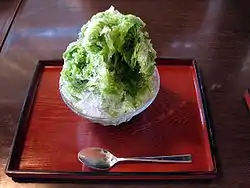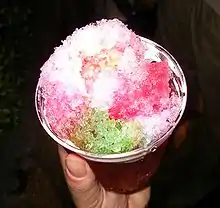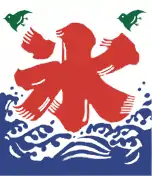Kakigōri
Kakigōri (かき氷) is a Japanese shaved ice dessert flavored with syrup and a sweetener, often condensed milk.[1]
 Kakigōri with green tea flavor | |
| Type | Shaved ice |
|---|---|
| Course | Dessert |
| Place of origin | Japan |
| Main ingredients | Ice, syrup, condensed milk or evaporated milk |
| Variations | Shirokuma |

History
The origins of kakigōri date back the Heian period in Japanese history, when blocks of ice saved during the colder months would be shaved and served with sweet syrup to Japanese aristocracy during the summer.[2] Kakigōri's origin is referred to in The Pillow Book, a book of observations written by Sei Shōnagon, who served the Imperial Court during the Heian period.[3][4] Kakigōri became more accessible in the 19th century, when ice became more widely available to the public during the summertime.[5] The first kakigōri store is believed to have opened in Yokohama in 1869.[6]
July 25th is known as kakigōri day in Japan because of its pronunciation sounding similar to summer ice in Japanese.[7] Another reasoning for July 25th being kakigōri day is because, on that day in 1933, there was a record high temperature in Japan.[8]
Description
The traditional way of making kakigōri uses a hand cranked machine to spin a block of ice over a shaving blade.[9][5] Even though electric shavers are most often used, street vendors can still be seen hand-shaving ice blocks in the summer.
Rather than flavored ice, Kakigōri is traditionally made of pure ice, in many cases, being a frozen block of mineral water. The ice used is often taken from natural springs, afterward being tempered to achieve an ideal quality for shaving.[10][11] Prior to refrigeration, mountain caves or ice houses would be the traditional way of storing kakigōri ice.[5]
It is similar to a snow cone but with some notable differences: It has a much smoother fluffier ice consistency, much like fresh fallen snow, and a spoon is almost always used to eat it. The texture of the ice distinguishes kakigōri from other types of shaved ice desserts. Due to this textural difference, it has also been seen translated as 'Angel Snow', which perhaps sounds more appealing. [9]
Popular flavors include strawberry, cherry, lemon, green tea, grape, melon, "Blue Hawaii", sweet plum, and colorless syrup. Some shops provide colorful varieties by using two or more syrups. To sweeten kakigōri, condensed or evaporated milk is often poured on top of it.

In addition to street stalls, kakigōri is sold in festivals, convenience stores, coffee shops, specialized kakigōri parlors, and restaurants. It's also frequently prepared by families at home.[12] During the hot summer months, kakigōri is sold virtually everywhere in Japan. Especially at summer festivals and fairs such as matsuri and bon odori festivals, often served alongside other street foods such as yakisoba, takoyaki and cotton candy.[13] Kakigōri is one of the summer features in Japan. Some shops serve it with ice cream and sweetened red beans or tapioca pearls.
A flag with the kanji sign for ice kōri (氷) is a common and traditional way for an establishment to indicate that they are serving kakigōri.[14]
Shirokuma
 | |
| Type | Kakigōri |
|---|---|
| Course | Dessert |
| Place of origin | Japan |
| Region or state | Kagoshima prefecture |
| Main ingredients | Ice, condensed milk |
Shirokuma (白熊 or しろくま) is a type of kakigōri, a Japanese dessert made from shaved ice flavored with condensed milk, small colorful mochi, fruits, and sweet bean paste (usually Azuki bean). Mandarin oranges, cherries, pineapples, and raisins are often used to make shirokuma.
Description
Shirokuma has been popular in Kagoshima since the middle of the Edo period and is well known to many Japanese. Condensed milk, fruit, and sweet bean paste are served over shaved ice. It is eaten in cafés and in some department stores, such as Yamakataya (山形屋) or Mujaki.
Etymology
Shirokuma literally means "white bear" and indicates "polar bear" in Japanese. There are some views about the origin of the name.
In one account, there was a cotton shop in Kagoshima city. The shop started to sell kakigōri as its side-business. The kakigōri was flavored with condensed milk. When the owner was thinking of a name for it, he noticed the picture of a polar bear was printed on the labels of the condensed milk's can.
Another account is that Mujaki, a coffee shop in Kagoshima City, started to sell the kakigōri, put milk syrup, sanshoku-kanten (colorful agar), yōkan (soft azuki-bean jelly), sweet beans and fruits in a pattern that resembled a polar bear when seen from overhead, so it was named shirokuma.
Yet others say that it was created in honour of the memory of Saigo Takamori after his battle with the Edo Shogun.
In Kagoshima, some similar named kakigōri are made. Kurokuma flavored with dark brown unrefined sugar syrup, coffee or caramel syrup and kiguma flavored with mango pulp syrup are made in some coffee shops.
Availability
Supermarkets in southern Kyushu, especially in Kagoshima City, Kagoshima, and mom-and-pop candy stores sell shirokuma as a popular product. Shirokuma are often eaten at Kagoshima fairs which are held in other prefectures. Shirokuma in cups are sold at convenience stores all over Japan.
Ujikintoki
.jpg.webp)
Ujikintoki (宇治金時 or うじきんとき) is a type of Kakigōri that is made from shaved ice, flavored green tea syrup, sweet bean paste (Azuki bean), mochi, and green tea ice cream (抹茶アイスクリーム, Matcha aisu kurīmu).[15][16]
Other Varieties
See also
Similar dishes in other cultures
- Baobing: a Chinese shaved ice
- Patbingsu: a Korean shaved ice
- Halo-halo: a Philippine shaved ice (derived from Japanese Kakigori)
- Es campur: an Indonesian shaved ice
- Es teler: an Indonesian shaved ice
- Ais Kacang (ABC): a Malaysian shaved ice
- Grattachecca: an Italian shaved ice popular in Rome.
- Hawaiian shave ice: a Hawaiian shaved ice
- Granizado: a Costa Rican shaved ice
- Raspado: a Latin American shaved ice
References
- 新明解国語辞典(第6版)、三省堂
- "Nice ice, baby: what's in those pricier Japanese shaved ice desserts". South China Morning Post. 2019-08-18. Retrieved 2020-04-08.
- "The Pillow Book". Ancient History Encyclopedia. Retrieved 2020-04-08.
- News-Yomiuri, By Nao Yako Japan; Sept. 26, 2019 (2019-09-26). "Natural ice becoming popular source for shaved frozen treat". Honolulu Star-Advertiser. Retrieved 2020-04-09.CS1 maint: numeric names: authors list (link)
- Krishna, Priya (March 15, 2018), "Kakigori Is an Ancient Frozen Japanese Specialty – Now It's America's Hottest Dessert, Too", Grub Street
- 進藤つばら. "江戸時代は半年以上かけて氷を運んでいた。清少納言も食べていた「かき氷」の深〜い歴史に迫る | 和樂web 日本文化の入り口マガジン". 和樂web 日本文化の入り口マガジン (in Japanese). Retrieved 2020-04-08.
- "Japan's kakigori or a shaved ice dessert | iN HAMAMATSU.COM". www.inhamamatsu.com. Retrieved 2020-04-08.
- "かき氷の日 - 今日は何の日?食べ物編". today.jpn.org. Retrieved 2020-04-08.
- Rao, Tejol (September 17, 2018), "An Avalanche of Japanese Shave Ice", The New York Times
- Ch, Fiona; ra. "9 Kinds Of Shave Ice From Around The World — And Where To Find Them In LA". LAist. Retrieved 2020-04-08.
- "What Is Kakigori?". Tasting Table. 2018-07-09. Retrieved 2020-04-08.
- "Kakigori – The Tip Of The (Shaved) Iceberg". Metropolis Magazine. 2017-08-17. Retrieved 2020-04-08.
- "Shaved ice cools down the Japanese summer". Stripes Okinawa. 2019-07-01. Retrieved 2020-04-08.
- "Kakigōri". nippon.com. 2017-07-29. Retrieved 2020-04-08.
- "An Easy Recipe for Ujikintoki Kakigori, a Wonderful Japanese Treat". The Spruce Eats. Retrieved 2020-04-08.
- "Travel the World Through 5 Shave Ice Spots". www.honolulumagazine.com. Retrieved 2020-04-08.
- "A Trip To Uji". Inside Kyoto. Retrieved 2020-04-08.
- "金時の意味? | 食育大事典". shokuiku-daijiten.com (in Japanese). Retrieved 2020-04-08.
- "Kintaro in Japanese Folklore and Art – Modern Tokyo Times". Retrieved 2020-04-08.
- "焼き氷(やきごおり)とは何? Weblio辞書". www.weblio.jp. Retrieved 2020-04-09.
- "焼き氷 - 焼き氷の概要 - Weblio辞書". www.weblio.jp. Retrieved 2020-04-09.
External links
| Wikimedia Commons has media related to Shirokuma. |
- 天文館むじゃき (Japanese)
- かごしま遊楽館 (Japanese)
- セイカ食品株式会社:南国白くま (Japanese)
- 鹿児島 山形屋 (Japanese)
- You can eat a polar bear in Kagoshima Rocket NEWS 24 (English)